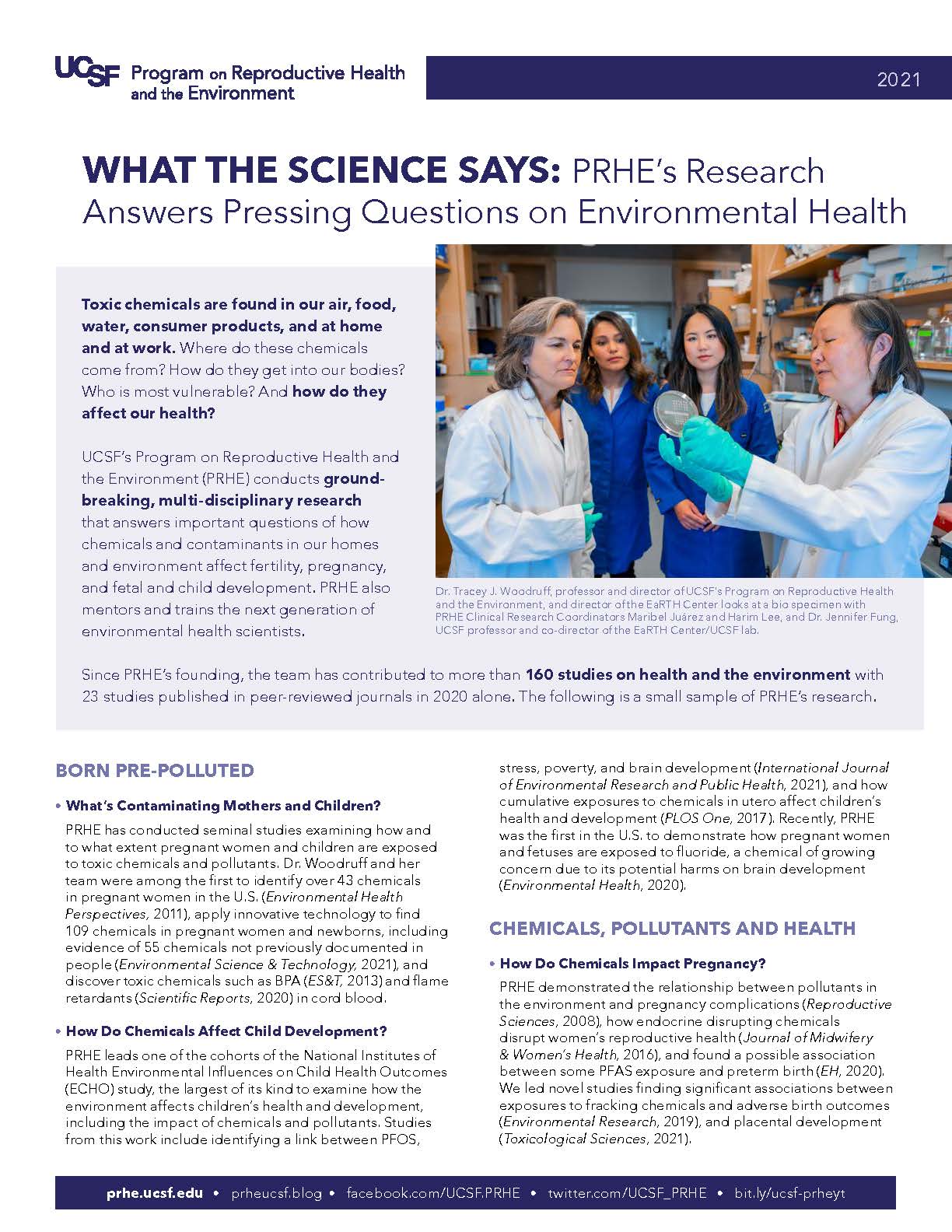Investigating environmental links to disease
Our ground-breaking, multidisciplinary research answers important questions on how chemicals and contaminants in our homes and environment affect fertility, pregnancy, fetal and child development, and health equity. We prioritize filling gaps in knowledge that support clinical decision-making and public policy.
We have written or contributed to more than 180 studies on health and the environment with 23 studies published in peer-reviewed journals in 2020 alone.
UCSF Study Finds Evidence of 55 Chemicals Never Before Reported in People
Scientists at UC San Francisco have detected 109 chemicals in a study of pregnant women, including 55 chemicals never before reported in people and 42 “mystery chemicals,” whose sources and uses are unknown. The chemicals most likely come from consumer products or other industrial sources.
The study was published March 17 in Environmental Science & Technology.
Major Research Areas

Chemicals
We study how harmful chemicals put into our air, food, water, homes, products, and workplaces affect pregnancy, child development, and health.

Plastics
Plastics are a petro-chemical product packed with endocrine-disrupting chemicals that can harm pregnancy, birth outcomes, neurodevelopment, and immune systems.

Climate and Wildfires
We examine how climate is impacting women's and children's health and how to protect pregnant people from wildfire smoke.
Key Research Projects

ECHO
The Environmental Influences on Child Health Outcomes (ECHO) is the largest NIH-funded study to date to explore how chemicals and pollutants in our environment impact pregnancy and child development.

DREAM
The Discovering cancer Risks from Environmental contaminants And Maternal/child health (DREAM) project collected data to explore how chemicals put in our air, food, and water increase cancer risk.

ENACT Center
In partnership with Stanford University, the Endometriosis Center for Action, Community Engagement and Training (ENACT) will work to improve endometriosis diagnosis and treatment by exploring the origins and environmental links to this disease.

PRHE conducts groundbreaking, multi-disciplinary research that answers important questions of how chemicals and contaminants in our homes and environment affect fertility, pregnancy, and fetal and child development. PRHE also mentors and trains the next generation of environmental health scientists.
Published Studies
Dietary alterations can reduce exposure to endocrine disruptors, with limited data on interventions to improve endocrine-disruptor–related clinical outcomes. This review provides useful instruction to women, their families, healthcare providers, and regulatory bodies.
Climate change continues to result in increased exposure to wildfires in California and around the world with smoke reaching far more populations than in recent years. There is increased concern for the health effects of these fires, especially for pregnant people and their developing foetuses.
Wildfire, pregnancy, California, birth defects, commentary
Occupational exposures to flame retardants (FRs), a class of suspected endocrine-disrupting compounds, are of health concern for firefighters. We sought to characterize exposure to FR compounds and evaluate their association with thyroid hormone levels, a biomarker of early effect, in female firefighters and office workers in San Francisco.
Per- and poly-fluoroalkyl substances (PFAS) are commonly detected in a variety of foods and food packaging materials. However, few studies have examined diet as a potential source of PFAS exposure during pregnancy. In the present cross-sectional study, we examined prenatal PFAS levels in relation to self-reported consumption of meats, dairy products, and processed foods during pregnancy.
The concept of the exposome was introduced over 15 years ago to reflect the important role that the environment exerts on health and disease. While originally viewed as a call-to-arms to develop more comprehensive exposure assessment methods applicable at the individual level and throughout the life course, the scope of the exposome has now expanded to include the associated biological response.
Environmental chemical exposures can affect telomere length, which in turn has been associated with adverse health outcomes including cancer. Firefighters are occupationally exposed to many hazardous chemicals and have higher rates of certain cancers.
Non-targeted analysis (NTA), including both suspect screening analysis (SSA) and unknown compound analysis, has gained increasing popularity in various fields for its capability in identifying new compounds of interests. Current major challenges for NTA SSA are that (1) tremendous effort and resources are needed for large-scale identification and confirmation of suspect chemicals and (2) suspect chemicals generally show low matching rates during identification and confirmation processes.

